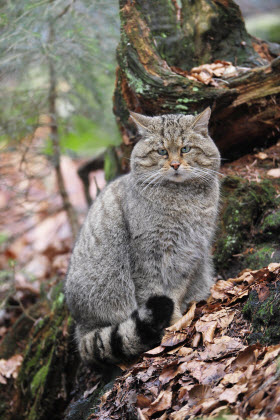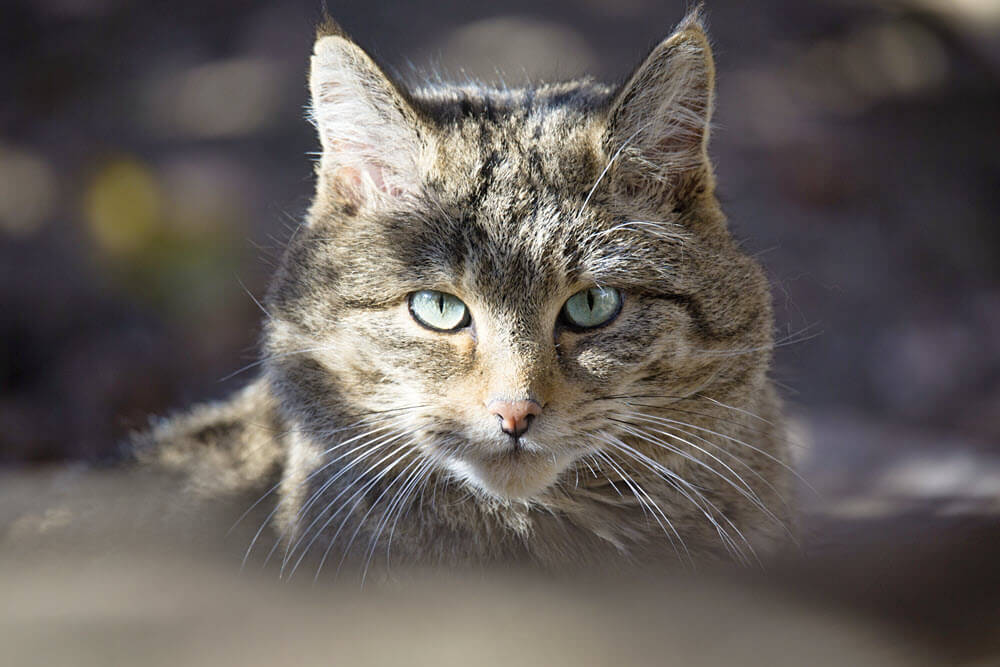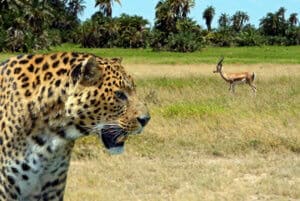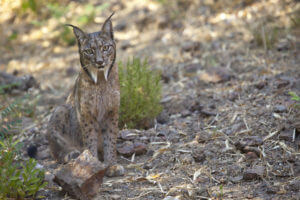The European wildcat is a small wild cat found throughout Europe. It is one of five general groups of wildcats.
Scientific Name: Felis silvestris
Estimated total population: 500,000
Conservation Status: Least Concern
Despite its relatively high numbers and and IUCN status of Least Concern, the European wildcat is still considered rare and elusive.
Subspecies (valid as of 2017):
- F. s. silvestris – the original species (Europe, Sicily and Scotland)
- F. s. caucasian (Turkey and the region between the Black Sea and Caspian Sea)
Lineage – The European wildcat belongs to the Domestic Cat lineage, which includes the Jungle cat, black-footed cat, sand cat, Chinese mountain cat, African wildcat and domestic cat.
Interesting European wildcat facts
- Its scientific name was first proposed in 1778.
- The European wildcat separated from a common Felis species ancestor between .02 and 4.1 million years ago, after the jungle cat, black-footed cat, sand cat, and African wildcat.
- It is a good climber but hunts mainly on the ground.
- They are the size of a domestic cat but look larger because of their thick, long fur.
More about the European Wildcat
European wildcats are a subspecies of wildcat that evolved around 650,000 years ago. They are also an ancestor of today’s domesticated house cat, often compared to striped tabby cats, with larger heads, longer legs, and a sturdier build.
Physical characteristics
European wildcats are about 1/3 larger than domestic cats. Their fur varies in color from brown to grey, and they have a bushy-looking, round-tip tail with dark bands. They also have thick, striped fur and white whiskers.
There are five stripes on the cat’s forehead and a dark stripe that extends from the shoulders to the base of the tail. Irregular stripes appear on the sides, becoming blotches toward the hind legs.
Male cats weigh 11 lbs. to 18 lbs. Females are smaller and weigh an average of 7.5 lbs. European wildcats are around 22-28 inches long and 12 inches tall. They have good night vision and an excellent sense of smell.
| Male European wildcat | FROM | TO |
| Weight | 11 lbs. | 18 lbs. |
| Length | 22 in. | 28 in. |
| Tail | 10 in. | 14 in. |
Location, populations, and habitat
European wildcats are typically found in forests across Europe, Turkey, and the Caucasus Mountains, which stretch between the Caspian and Black Seas. The cat has been considered extinct in Scandinavia, England, Wales, and the Netherlands. However, some believe it may now be expanding its range and returning to the Netherlands from nearby countries. It may also be extinct in the Czech Republic.
The cat’s total population is estimated to be 500,000. The largest populations are in Spain and Portugal. In some countries, the cat is extinct or lives in fragmented groups. In 2014, researchers found an unknown population of European wildcats living in a forested area around Mount Etna, an active volcano located in Sicily. There are also two populations in France. They have also been found in the Jura Mountains in Switzerland and the Polish Carpathian Mountains.
Generally, they inhabit forested areas with trees that have large leaves. They stay away from human settlements and agricultural areas. The European wildcat has also been seen in grasslands, steppes, and scrublands.
General behavior
It leads a solitary life except during mating and is primarily active at night. It marks its territory with scents (urine and feces) at different locations and will also scratch trees.
Hunting & Prey
 The European wildcat is generally considered a nocturnal animal. Sometimes, the cat will be active in places with minimal human activity during the day. They have also been seen scavenging for food on the outskirts of cities and towns. Mainly, European wildcats hunt around Twilight. They will wait on the ground for their prey and then leap up to 3 or 4 feet to catch it. The cat feeds on rabbits, mice, voles, rats, squirrels, weasels, waterfowl, and even small deer. Some cats will also prey on domestic cats, small dogs, and poultry.
The European wildcat is generally considered a nocturnal animal. Sometimes, the cat will be active in places with minimal human activity during the day. They have also been seen scavenging for food on the outskirts of cities and towns. Mainly, European wildcats hunt around Twilight. They will wait on the ground for their prey and then leap up to 3 or 4 feet to catch it. The cat feeds on rabbits, mice, voles, rats, squirrels, weasels, waterfowl, and even small deer. Some cats will also prey on domestic cats, small dogs, and poultry.
Mating and reproduction
European wildcats usually create dens in hallowed-out trees or use the abandoned nests and dens of other animals, such as herons, foxes, and badgers.
The cat is sexually active from December to February and May to June. During the mating season, it is common to find males fighting over a female. From April to May, the female will have 1 to 7 kittens. The kittens will begin hunting with their mother approximately two months after birth. At five months old, they will become more independent.
European wildcats are mostly fully grown when they reach ten months of age, also around the time they become sexually active.
They can live up to 21 years, but most will have a shorter lifespan, usually within the 13 to 14-year range.
Except during periods of breeding, European wildcats are usually solitary animals.
Conservation
The European wildcat is legally protected. However, it can be mistaken for feral cats and shot. Interbreeding with feral cats is one of the biggest threats to European wildcats.


















0 Comments